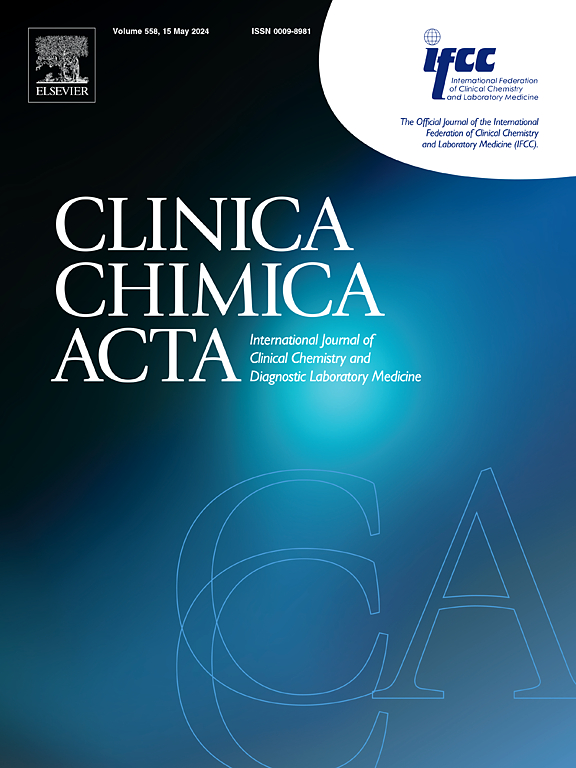Emerging blood biomarkers in Alzheimer’s disease: a proteomic perspective
IF 3.2
3区 医学
Q2 MEDICAL LABORATORY TECHNOLOGY
引用次数: 0
Abstract
Early detection of Alzheimer’s disease (AD) remains a formidable clinical challenge, but emerging blood-based assays show promise for identifying at-risk individuals long before cognitive symptoms arise. This is the first comprehensive synthesis comparing mass-spectrometry and immunoassay platforms across multiple blood-based AD biomarkers and the first to integrate these findings into a unified roadmap for clinical implementation. In this review, we compare high-throughput mass spectrometry and ultrasensitive immunoassays for quantifying circulating amyloid-β isoforms, phosphorylated tau species (p-tau181, p-tau217), neurofilament light chain (NfL), glial fibrillary acidic protein (GFAP), YKL-40 and selected inflammatory markers. Individual biomarkers demonstrate diagnostic accuracies (AUC) up to 0.90, and integrating these protein signatures with APOE ε4 genotype, brief cognitive assessments and neuroimaging via machine-learning models boosts discrimination of preclinical AD from normal aging to over 80% accuracy. We trace the path from initial discovery through analytical validation to clinical implementation, emphasizing critical hurdles such as variability in sample collection, limited cohort diversity and regulatory requirements. Future work must standardize preanalytical protocols, extend validation across populations, refine ultrasensitive detection techniques, and combine proteomic data with genomics and other “omics” layers to move toward routine blood-based screening. These coordinated efforts provide a clear roadmap for transforming early AD diagnosis and enabling timely, personalized interventions.
阿尔茨海默病新出现的血液生物标志物:蛋白质组学的观点
阿尔茨海默病(AD)的早期检测仍然是一项艰巨的临床挑战,但新兴的基于血液的检测显示出在认知症状出现之前识别高危个体的希望。这是第一个综合比较多种血液AD生物标志物的质谱分析和免疫分析平台,也是第一个将这些发现整合到临床实施的统一路线图中的研究。在这篇综述中,我们比较了高通量质谱法和超灵敏免疫分析法用于定量循环淀粉样蛋白-β亚型,磷酸化tau物种(p-tau181, p-tau217),神经丝轻链(NfL),胶质纤维酸性蛋白(GFAP), YKL-40和选定的炎症标志物。单个生物标志物的诊断准确度(AUC)高达0.90,通过机器学习模型将这些蛋白质特征与APOE ε4基因型、简短认知评估和神经成像相结合,可将临床前AD与正常衰老的区分准确率提高到80%以上。我们追溯了从最初的发现到分析验证再到临床实施的路径,强调了关键的障碍,如样本收集的可变性、有限的队列多样性和监管要求。未来的工作必须标准化分析前协议,扩展人群验证,改进超灵敏检测技术,并将蛋白质组学数据与基因组学和其他“组学”层结合起来,以实现常规血液筛查。这些协调一致的努力为改变阿尔茨海默病的早期诊断和实现及时、个性化的干预提供了明确的路线图。
本文章由计算机程序翻译,如有差异,请以英文原文为准。
求助全文
约1分钟内获得全文
求助全文
来源期刊

Clinica Chimica Acta
医学-医学实验技术
CiteScore
10.10
自引率
2.00%
发文量
1268
审稿时长
23 days
期刊介绍:
The Official Journal of the International Federation of Clinical Chemistry and Laboratory Medicine (IFCC)
Clinica Chimica Acta is a high-quality journal which publishes original Research Communications in the field of clinical chemistry and laboratory medicine, defined as the diagnostic application of chemistry, biochemistry, immunochemistry, biochemical aspects of hematology, toxicology, and molecular biology to the study of human disease in body fluids and cells.
The objective of the journal is to publish novel information leading to a better understanding of biological mechanisms of human diseases, their prevention, diagnosis, and patient management. Reports of an applied clinical character are also welcome. Papers concerned with normal metabolic processes or with constituents of normal cells or body fluids, such as reports of experimental or clinical studies in animals, are only considered when they are clearly and directly relevant to human disease. Evaluation of commercial products have a low priority for publication, unless they are novel or represent a technological breakthrough. Studies dealing with effects of drugs and natural products and studies dealing with the redox status in various diseases are not within the journal''s scope. Development and evaluation of novel analytical methodologies where applicable to diagnostic clinical chemistry and laboratory medicine, including point-of-care testing, and topics on laboratory management and informatics will also be considered. Studies focused on emerging diagnostic technologies and (big) data analysis procedures including digitalization, mobile Health, and artificial Intelligence applied to Laboratory Medicine are also of interest.
 求助内容:
求助内容: 应助结果提醒方式:
应助结果提醒方式:


